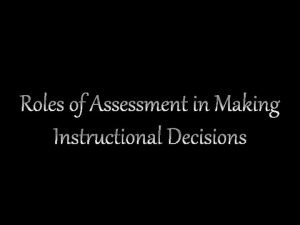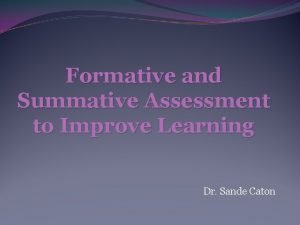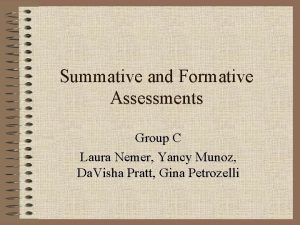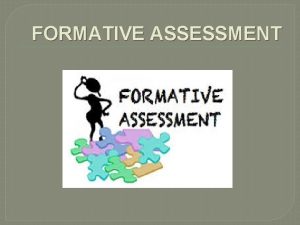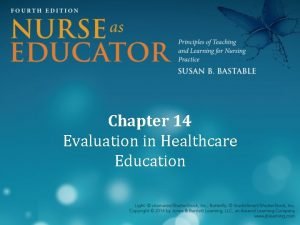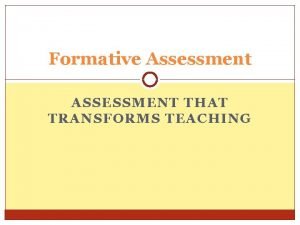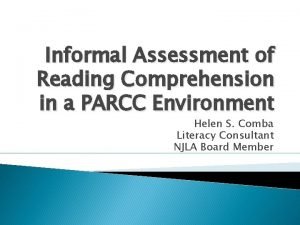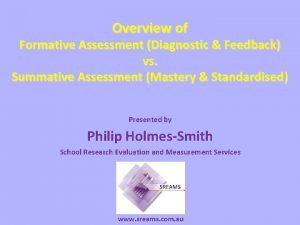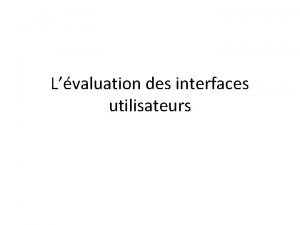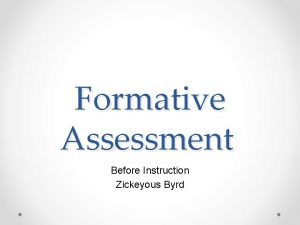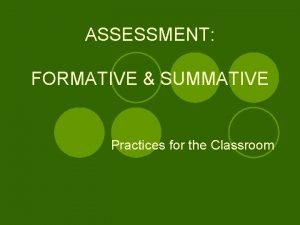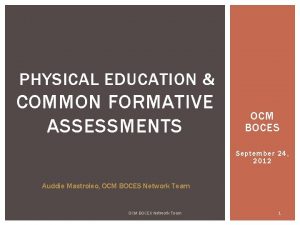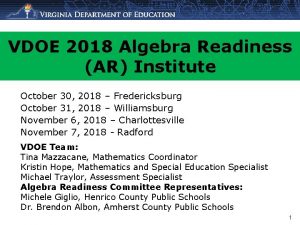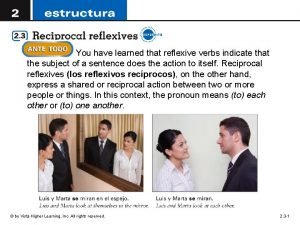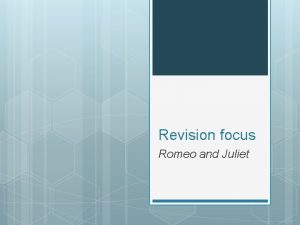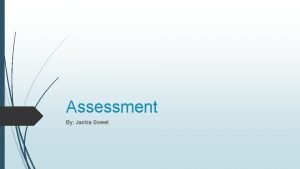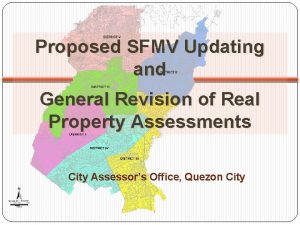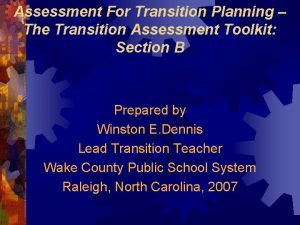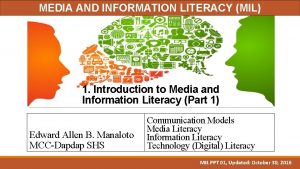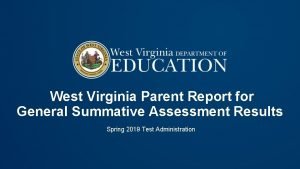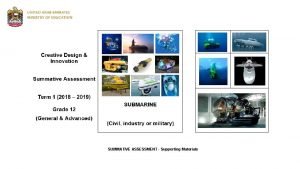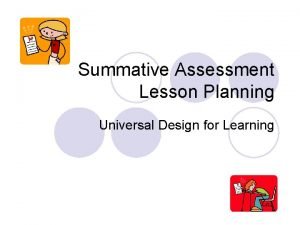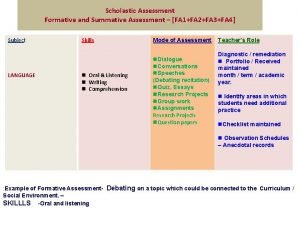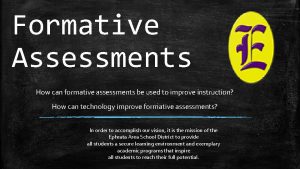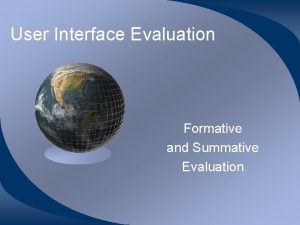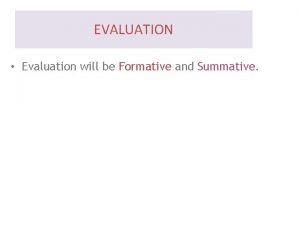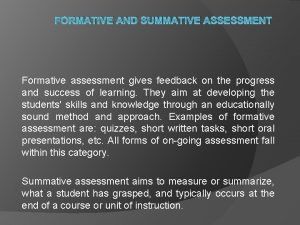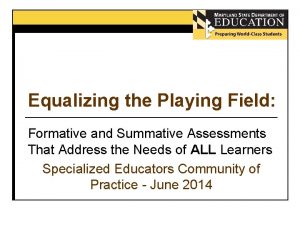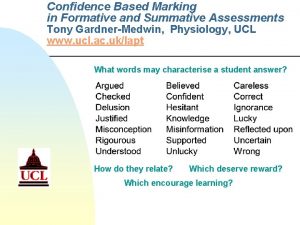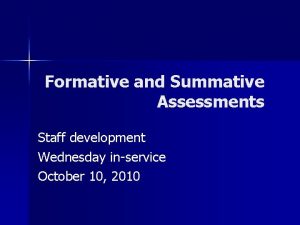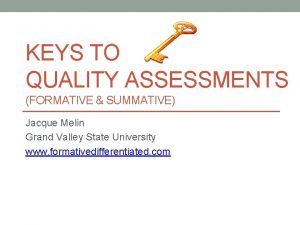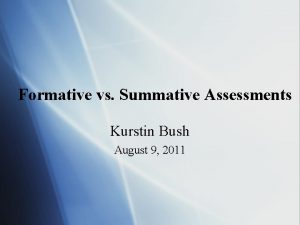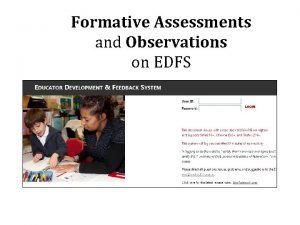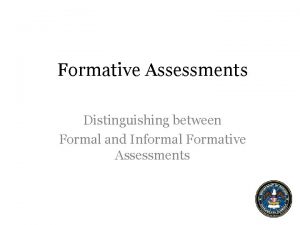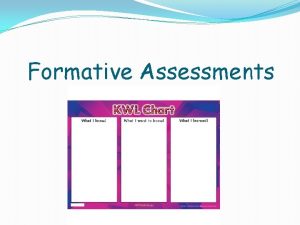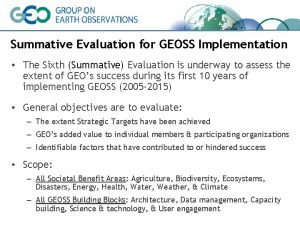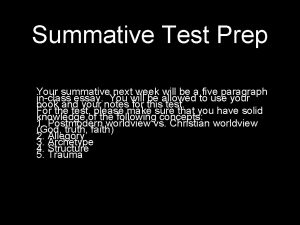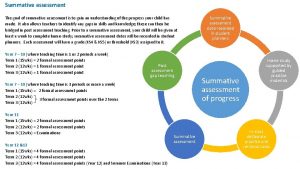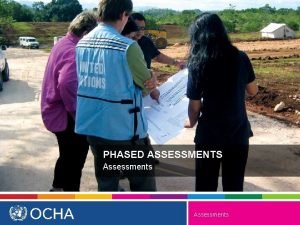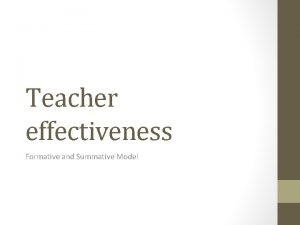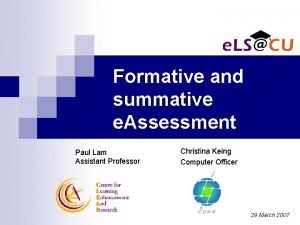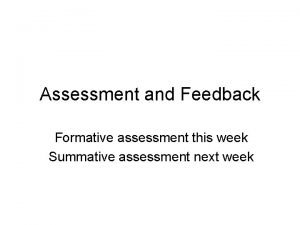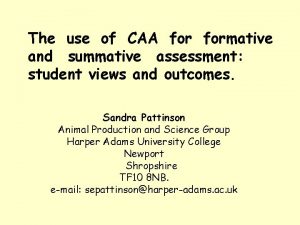Summative and Formative Assessments Group C Laura Nemer






























- Slides: 30

Summative and Formative Assessments Group C Laura Nemer, Yancy Munoz, Da. Visha Pratt, Gina Petrozelli

Introduction “Formative and summative evaluations are the two primary methods of evaluation currently in vogue. ” (Dr. K. , Week 7, Lecture 7)

Summative Evaluations • Summative evaluations take place at the end of a specific time frame. • As for teacher evaluations and observations, summative assessments take place midway through the year and at the end of the year. • Summative evaluations are formal in nature and do not allow for much feedback.

Formative Evaluations • Formative evaluations are ongoing. • They are usually informal and come in the form of a checklist or anecdotal records. • Formative evaluations provide immediate feedback. • They ensure teacher effectiveness and success as they monitor progress throughout the school year.

Teacher Observations and Evaluations • Supervisors and administrators have a great responsibility when it comes to observing and evaluating staff members.

Teacher Observations and Evaluations • It is important that administrators do not solely rely on SUMMATIVE assessments. • Many do because of the demands of their positions. • Supervisors and administrators must utilize both forms of assessment to ensure accurate data collection and recommendations

FORMATIVE vs. SUMMATIVE ASSESSMENTS THE DIFFERENCES

FORMATIVE • Little more complex • Completed during development of program • Conducted more than once • Research oriented--intent is to improve

• “Coaching for success” – Ensure goals are being met – Provide feedback • “Learning spiraling upwards” • Not necessarily in need of, or to evaluate, a “product” • Assessments usually remain “in-house”

TYPES • • • ANECDOTAL RECORDS QUIZZES ESSAYS DIAGNOSTIC TESTS LAB REPORTS

SUMMATIVE • Quantitative • Information gathered/completed at the end of a program • Cumulative learning • Measure effectiveness • Assess end result • Used to make decisions about further study

TYPES • • • UNIT TESTS FINAL EXAMS STATEWIDE TESTS NATIONAL TESTS ENTRANCE EXAMS

The Link Between Formative & Summative Evaluation

Simply pointing out the differences between two forms of evaluation is not always very useful. True understanding isn’t always achieved Formative and Summative Evaluation forms are a lot like apples and oranges…

(Formative Vs. Summative) It is because of the similarity between the two forms of evaluation that pointing out the differences becomes fruitful Just as apples are different than oranges; None-the-less both are fruits, edible, and round

Both Formative and Summative Evaluation forms must be effective!

Key features of effective evaluation • • alignment validity reliability Transparency

Alignment There should be alignment between: • clear and realistic learning outcomes • learning opportunities to achieve these outcomes • evaluation methods and tasks related to the learning outcomes and methods of learning

Validity Evaluation should measure what it sets out to measure: • This is tipically pointed out during the preconference between the teacher and the administrator

Reliability Evaluation should be consistent and fair: • good assessor reliability – administrator with classroom experience preferably.

Transparency No 'hidden agendas' or surprises for teachers: • Teachers should not have to guess what is in the assessor's mind. • evaluation should be clearly aligned to published learning outcomes or a teacher personal improvement plan (PIP).

3 Purposes of Evaluation 1. To consistently promote growth. 2. To improve delivery of content to the students. 3. To ultimately improve the learning of the students (the accountability piece).

Words of Wisdom • “teachers can fix bad teaching; they find it very difficult to escape bad evaluations. ” • “Nothing that we do to, or for, our teachers is more important than our evaluation of their work and the feedback administrators and peers give them on it. The results of our evaluations influence our teachers for the rest of their careers. ”

The best method of evaluation is

Formative evaluations • Provides on-going assessments, reviews, and observations in a classroom • Teachers use formative assessment to improve instructional methods with student feedback throughout the teaching and learning process. • Teacher observes students that do not grasp a concept, she or he can design a review activity or use a different instructional strategy. • students can monitor their own progress with periodic quizzes and performance tasks. • results of formative evaluations are used to modify and validate instruction.

The difference between formative and summative • The value of formative evaluation must express with the distinction to students in language they can grasp • Formative evaluation is the process of judging an ongoing, changing process or diagnosis, revision, description, information, or comparison. • Summative evaluation is a final-end decision serving purposes of persuasion, verification, prediction or validity • Where there is no formative evaluation, by definition, the student learns nothing after submitting the work

• While formative evaluation highlights areas that need improvement or remediation • Formative test results may lead to conclusions that other methods would be more effective. • preferably educators should incorporate both types of evaluation in program development.

Plan of the formative evaluation • Assess progress towards meeting the curriculum’s aims and objectives • Assess how effectively projects are contributing to meeting the curriculum • Gather and publish best practice • Identify gaps and issues • Raise awareness of the plan and stimulate discussion • Ensure that course outputs are meeting students needs • • Ensure the curriculum can respond flexibly to changes

REFERENCES • Classroom Assessment: Basic Concepts. Formative vs. Summative Assessments. Retrieved October 20, 2008 from http: //fcit. usf. edu/assessment/basica. html • Formative vs. Summative Evaluation. Retrieved October 20, 2008 from http. jan. ucc. nau. edu/edtech/etc/667/proposal/evaluation/summa tive_vs_formative. htm • Formative and Summative Assessment. Retrieved October 20, 2008 from http: //www. krauseinnovationcenter. org/ewyl/modules/module 63. html.

References • Classroom Assessment: Basic Concepts. Formative vs. Summative Assessments. Retrieved October 24, 2008 from http: //fcit. usf. edu/assessment/basica. html • Pawlas, G. , Oliva, P. (2008) Supervision for Today’s Schools, Sixth Edition. New York: John Wiley and Sons
 Formative assessments
Formative assessments Summative
Summative Laura nemer
Laura nemer Attributes of effective formative assessment
Attributes of effective formative assessment Evaluation in healthcare education
Evaluation in healthcare education Summative and formative assessment
Summative and formative assessment Formative test
Formative test Diagnostic feedback definition
Diagnostic feedback definition Example of naturalistic observation
Example of naturalistic observation Examples of formative assessment
Examples of formative assessment Formative vs summative
Formative vs summative Common formative assessment examples
Common formative assessment examples Formative assessment cycle
Formative assessment cycle Vdoe algebra readiness
Vdoe algebra readiness Adult assessment
Adult assessment Laura conocía bien a elián. elián conocía bien a laura.
Laura conocía bien a elián. elián conocía bien a laura. Romeo and juliet summative assessment
Romeo and juliet summative assessment Objectives of summative assessment
Objectives of summative assessment Summative and subjective assessment
Summative and subjective assessment General revision of assessments and property classification
General revision of assessments and property classification Formal and informal assessment
Formal and informal assessment Formal and informal assessment advantages and disadvantages
Formal and informal assessment advantages and disadvantages Physical fitness test grade 9
Physical fitness test grade 9 Mil venn diagram
Mil venn diagram Formative assessment analyze and explain this illustration
Formative assessment analyze and explain this illustration Wv general summative assessment
Wv general summative assessment Wv test administrator
Wv test administrator Wv air secure browser
Wv air secure browser Grade 12 summative test
Grade 12 summative test What is a summative assessment in a lesson plan
What is a summative assessment in a lesson plan Summative scale
Summative scale
